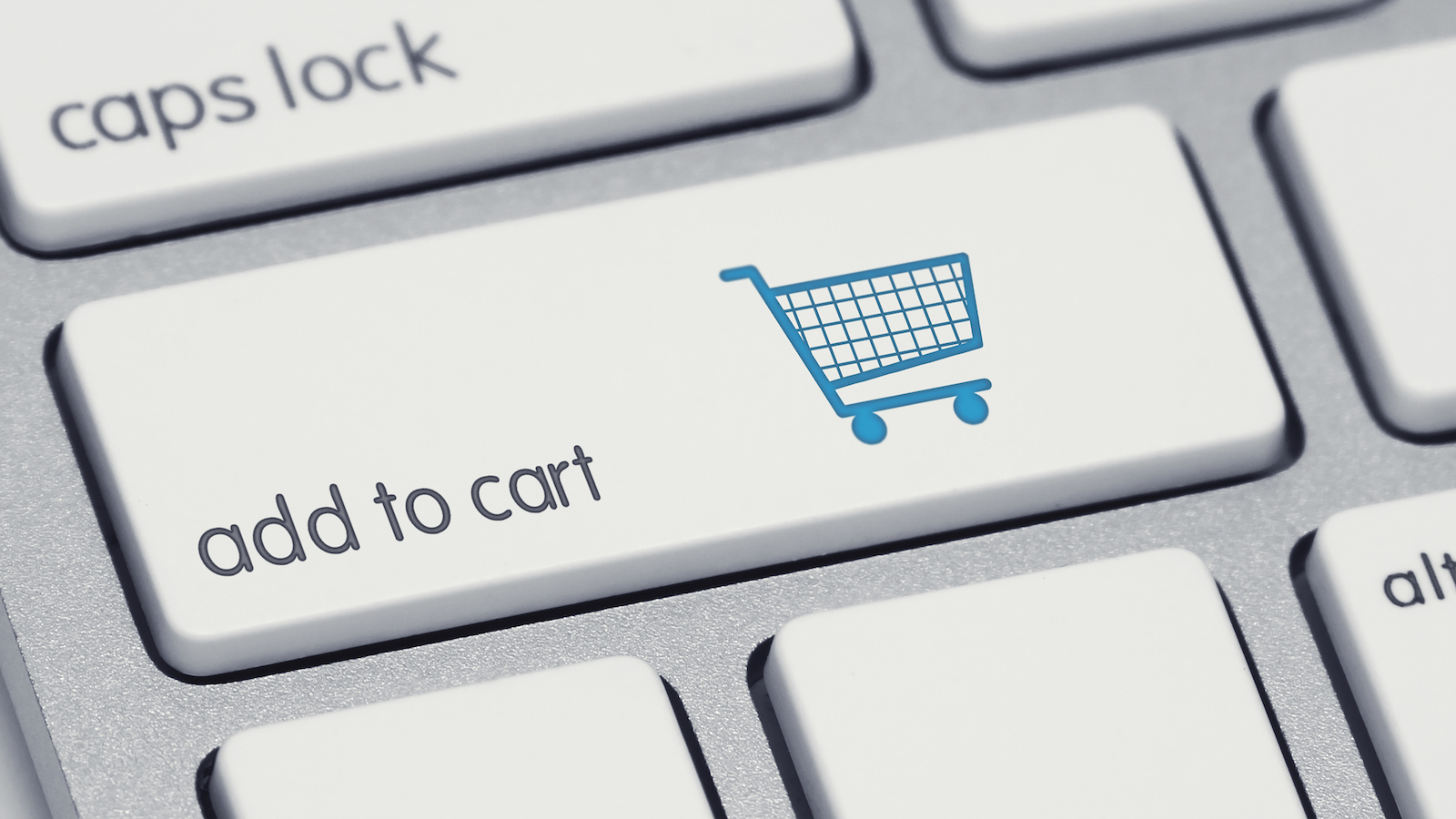Table of Contents
** Minutes
4 types of ecommerce product bundling strategies
3 examples of common product bundles
Why do ecommerce companies offer bundles at a discounted price?
Product bundling best practices
Logistical challenges of product bundling
What do you want to learn?
Burger and fries. Shoes and socks. Smartphone and charger.
Some things just go well together. That’s why product bundling is a common selling practice and is used across industries, from fast food restaurants to wireless companies.
In ecommerce, product bundling is a popular marketing strategy used across all markets from food and beverage, cosmetics, personal care products, and more.
While product bundling seems like a straightforward concept, it is built on consumer behavior psychology.
By offering a curated collection of products together in exchange for a discount, the customer feels good about getting a deal, even if they ultimately spend a little more in the long run.
For the business owner, it’s a cross-selling tactic that’s proven to drive more revenue and increase average order value(AOV).
Let’s take a closer look at what product bundling entails and the different types of product bundling strategies used in ecommerce.
What is product bundling?
Product bundling refers to grouping two or more related products together under one SKU (so only one item is added to the card), often at a lower price than it would cost to purchase these items individually.
It’s a common strategy ecommerce businesses use year-round to generate more revenue per order. It’s also a very popular marketing and cross-selling strategy around the holidays (since bundles can be pre-packaged to make gift-giving easier) or for one-off promotions.
4 types of ecommerce product bundling strategies
There are several ways to go about bundling your products to maximize revenue and improve your bottom line, from offering a discount for complementary products purchased together, to bundling a slow-moving item with a faster selling product.
Here are some of the most common product bundling strategies.
1. Mixed bundling
Mixed bundling is the most common type of product bundling. It’s based on products that are oftentimes sold together based on historical order data.
A great example of a brand doing this well is Boie, which sells sustainable toothbrushes, body scrubbers, and face scrubbers. All of their products can be sold individually (with different color options), but they also offer all three of their products in one bundle with a discounted price of $25 (which meets the minimum spend threshold to qualify for free shipping).

2. Pure bundling
Pure bundling refers to the grouping of products that are only available when sold together. For example, every time you purchase cough syrup, you also get a small plastic cup, which you would never buy separately. The problem with pure bundling is that it limits options for the customer to purchase items individually, which might lead to a dip in sales over time.
Here’s an example of pure bundling not working: A study done by Vineet Kumar for Harvard Business School discovered that when Nintendo mixed-bundled video games (that are also sold as individual units), the sale of individual video game units went up by 100,000 units, generating more than $1 million in sales. But when Nintendo tried pure bundling instead, which forced customers to buy video games as a bundle, their overall sales went down by 20%.
3. Same products
Same-product bundling is a great way to offer a discount when a customer orders multiple of the same product at once. Many direct-to-consumer (DTC) brands that sell essential or personal care products (e.g., toothpaste, paper towels, or hand soap) do great with this type of bundling strategy. Similar to a subscription model, same-product bundling incentivizes customers to buy in bulk upfront, rather than paying to ship a new order each time.
For instance, meal replacement brand Ample Meal gives customers plenty of options on how much they want to purchase upfront while showcasing the discount they’ll receive as they increase the quantity, which incentives a higher AOV. Customers not only have the option to choose their meal quantity, but they also can choose between single bottles or canisters.
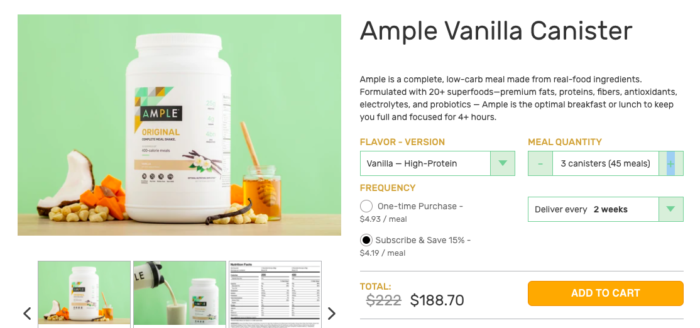
4. Excess inventory
Product bundling is not only one of the most effective marketing strategies, but it’s also a great way to clear out old, unwanted inventory to make room for new items. Slow-moving items can quickly increase inventory carrying costs, which can impact your bottom line.
If you have a SKU that isn’t selling as quickly as you’d like, you can easily bundle it with similar items that are either new, selling quicker, or are in higher demand. That way, you can deplete your supply to make room for new, faster-moving inventory.
3 examples of common product bundles
Think about your last few purchases — were any of them in a bundle? It’s highly possible. Here are a few examples of the most common products that are sold together.
1. Shampoo and conditioner
Shampoo and conditioner are often sold individually, but it’s not uncommon for brands to market these items together as a packaged deal. If a shopper is trying a new shampoo brand, they are more likely to also purchase the matching conditioner at a discounted price, especially if both items come in the same type of packaging.
While brick-and-mortar retailers have the option to display both items on the shelf together as a duo or even within the same packaging, online brands can take upselling a step further by bundling the set as one item.
2. Razor and razor blades
A razor and pack of razor blades make for a great product bundle since you’ll eventually need replacement cartridges and many specialty razors on the market have their own set of blades, which are not universal.
For instance, men’s shaving brand BAKblade offers several different bundles. Their ‘Elite Plus Bundle’ includes the shaver, a six-pack of blade refills, and even a wall mount. When a customer is ready to purchase more blades, they have the option to purchase a 12-pack and save 3%.
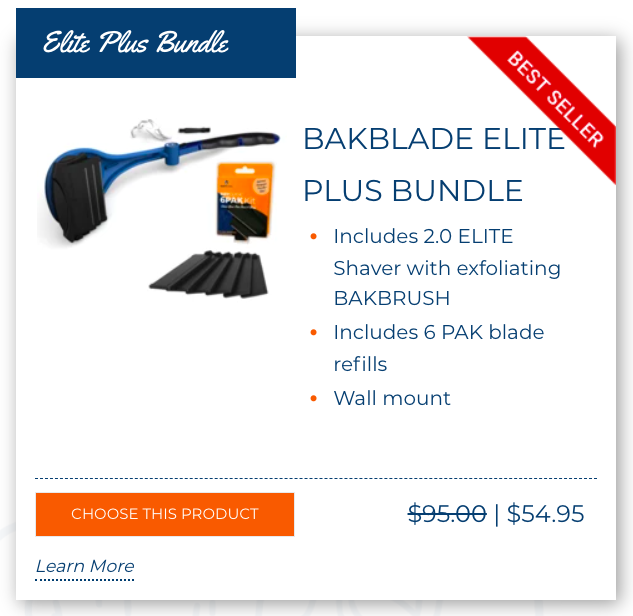
3. Diet food and beverage products
It can be a challenge to start a new diet and buy individual meals or components on your own. Diet-friendly bundles are great for brands that want to help their customers easily get started with a new diet routine.
Protein powder brand Synchro offers different levels of keto-friendly bundles, starting with ‘Keto Bundle 1,’ which includes protein powder and a keto-friendly chocolate bar along with a 4% savings. This way you get to try two of their products they recommend together rather than having to stare at many options to make a decision.
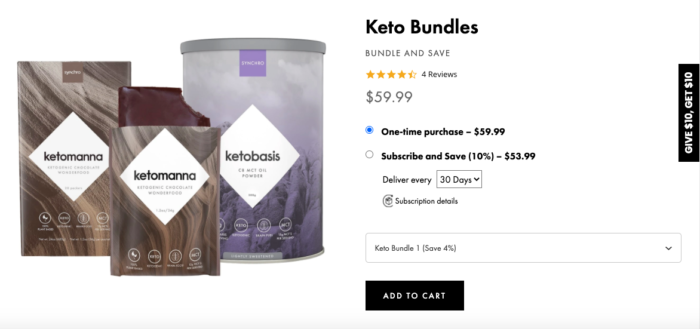
Why do ecommerce companies offer bundles at a discounted price?
Offering a discounted price is key to generating more sales with bundles. If you’re spending marketing dollars to attract shoppers to make a purchase on your store, your goal should be to get them to spend more per order, and a discounted bundle option does just that.
Product bundles can also encourage customers to meet the minimum spend thresholds for shipping, which also increases AOV and offsets the cost to offer free shipping.
From a fulfillment perspective, it costs as much time and labor to fulfill a sub-$10 product as it does a $100 product. However, the revenue you get is completely different. Besides bundling, if you can group products together so it’s one pick to fulfill the order, you may be able to save additional dollars.
“Bundles are such a no-brainer. I don’t understand why more brands don’t utilize them. You’re not only optimizing shipping costs but getting more product into their household.”
Nik Sharma, founder or Sharma Brands
How to sell a product bundle
There are a few factors to consider before you group two items together and hope that they sell. It’s important to get to know your customers’ buying behavior as well as which products shoppers often purchase together. Here are some tips on how to set up and sell a product bundle.
1. Choose the right product bundling strategy
Remember the Nintendo story mentioned earlier? Although product bundling is effective, not all bundling strategies work the same. Make sure to choose a product bundle option that works for you and continue to test. It can be as simple as one-time email promotion with A/B testing to see which bundle type works best.
Brian Greenberg of True Blue Life Insurance, states that “one of the best methods I’ve used in product bundling is looking at previous sales. What do common cohorts of customers purchase together? Using this data, you can segment further based on customer types and demographics, too, showing you invaluable data on what your typical customers already bundle and perceive as valuable.”
Historical data also provides great insight into what items are often purchased together. Always review past orders and repeat purchases to see what your customers typically try and/or purchase together. From there, you can strategically group items together that are more likely to generate more sales as a bundle.
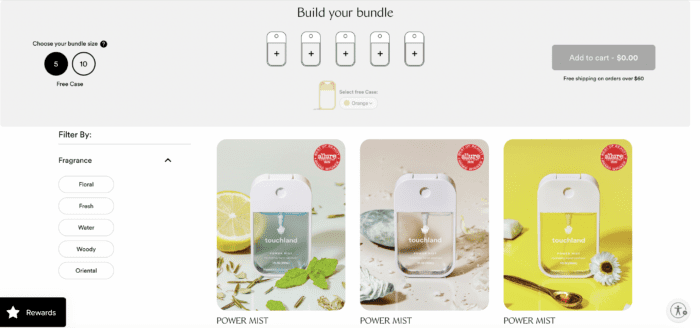
2. Showcase the discounted value
Shoppers won’t purchase a bundle unless the value of the discount is visible. When displaying bundle options on your online store and in promotions, it’s important to compare the price of each individual component within the bundle to the discounted price given when these items are purchased together. That way, it’s crystal clear how much the customer will save when purchasing the bundle.
Bundles go beyond just offering a discounted value by making it easy for shoppers to make a buying decision and save. For instance, if you see 50 options, you’re more likely to leave without buying anything. It’s best to keep it simple. For instance, even on your home page, you could feature no more than three options side-by-side along with the bundle option in the middle (knowing that most consumers choose the middle option).
Ecommerce brands should always be pushing bundle options first and foremost, making it a focus in marketing and on their online store.
3. Have the right logistics in place to manage bundles
Since there are so many different ways to group products together to create a bundle, you need a process that makes it easy to create and update bundles, especially when new ecommerce inventory comes in.
If you partner with a 3PL like ShipBob, creating and updating product bundles is easy to do. Not only does ShipBob fulfills orders quickly, but ecommerce brands can create a new bundle at any time using ShipBob’s intuitive dashboard. You can group multiple items together under one bundle, so they can be automatically shipped together.
“Bundling in ShipBob is my favorite feature. I can set up bundles quickly and it doesn’t change anything for customers on the front end, nor do I have to go to my packing company or manufacturer. I just link SKUs together in ShipBob and customers can buy 3-4 bracelets in a bundle.”
Torii Rowe, COO & Co-Founder of MANSSION
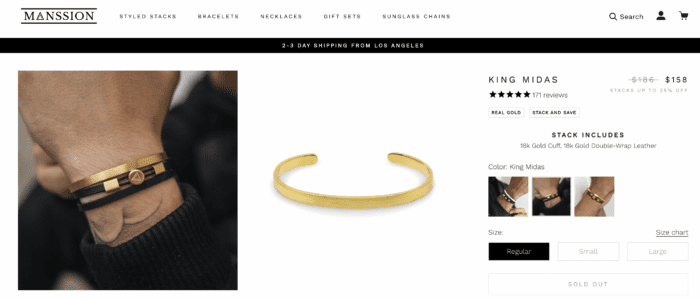
Each time the bundle is purchased on your store, there is no special assembly or extra preparation needed for the bundle to be shipped to your customer. It will be fulfilled, and you will be able to see which units were physically picked in the ShipBob fulfillment center. You can learn more about creating and managing bundles with ShipBob by clicking here.
““One thing that ShipBob enables us to offer on our DTC website that we don’t offer through B2B channels is product bundles. ShipBob’s dashboard makes it easy for us to create bundles of our reusable food storage options that are tailored to match different needs, which helps even more customers reach their sustainable kitchen goals. We can also update existing bundles, and synchronize inventory levels when bundled items are picked, packed, and shipped.””
Juliana Brasil, Director of Operations at Food Huggers
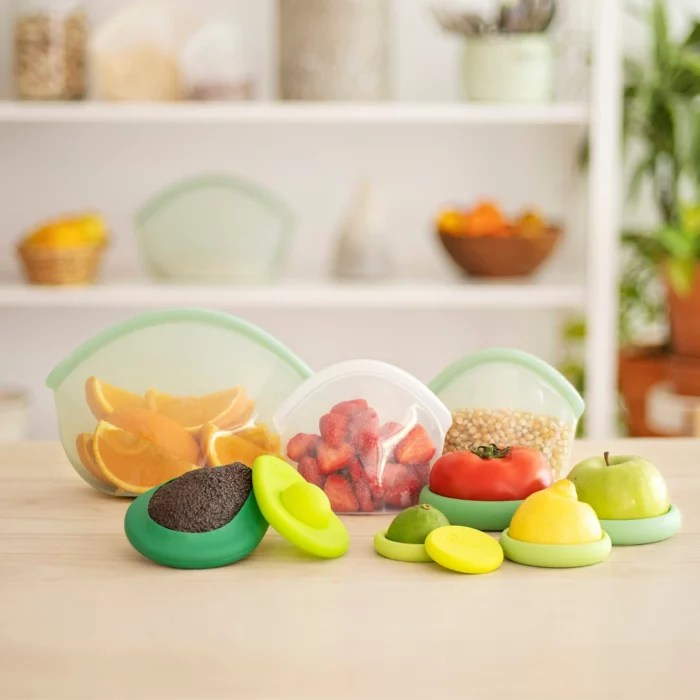
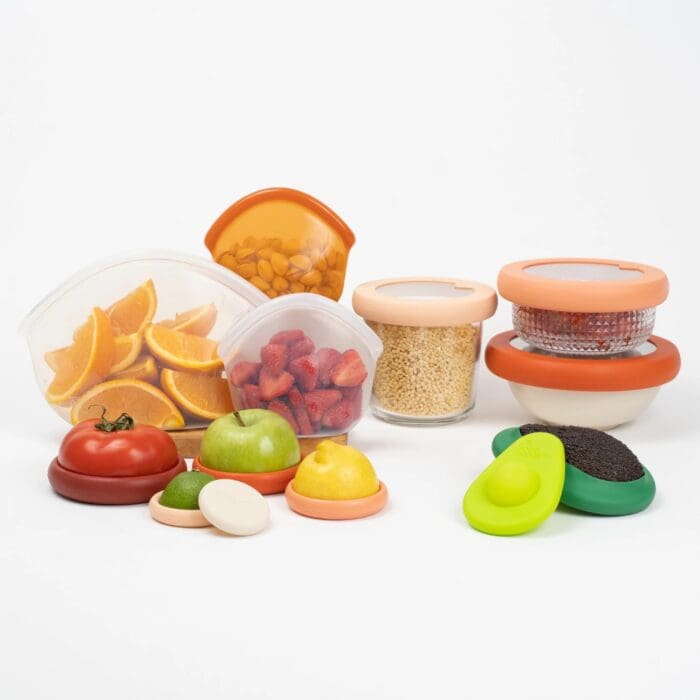
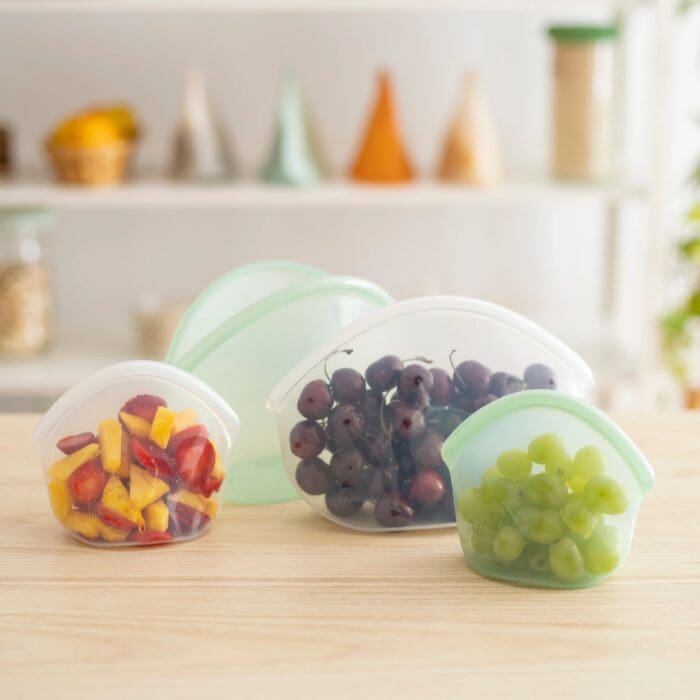
4. Offer special bundles for the holidays
With the holiday shopping season right around the corner, bundles make for great gift ideas. Gift sets can attract more customers by offering different products to try at a discounted price. For instance, luxury bath brand Bathorium offers several nicely packaged bundles, such as their “Crush” gift set, which includes six different bath soaks in smaller quantities.
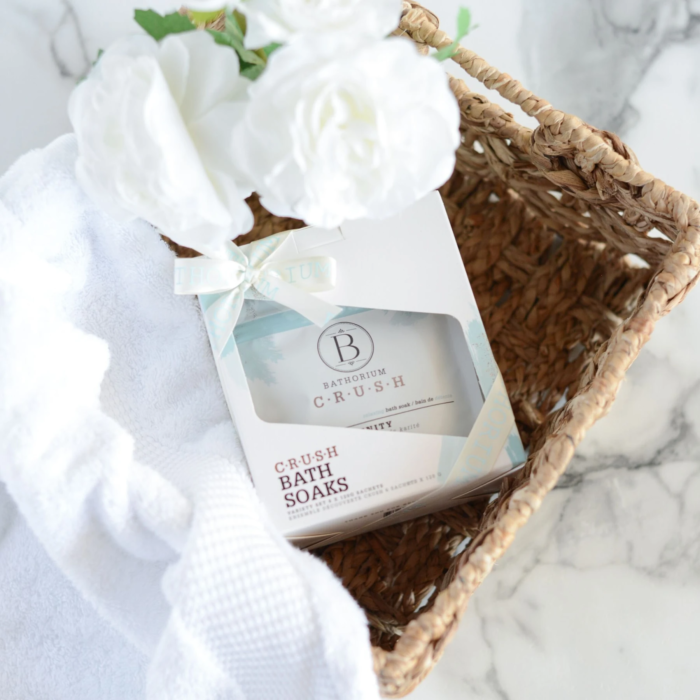
You can also offer different bundles for other holidays throughout the year, such as an eco-friendly bundle for Earth Day, or a Mother’s Day bundle with personal care items. There are endless themes you can play with to make different bundles more fun and enticing.
It’s always important to keep a close eye on what products customers are looking for and create a bundle accordingly. Fitness brand TB12 always sold fitness equipment, but like many ecommerce brands during COVID-19, they pivoted their bundle offering by introducing a ‘at home” resistance band kit.
Their innovative anchor system does not require you to drill holes into walls, so their resistance band kits let you set up a gym in your home, pack it all up in a drawstring band, and store it under your bed.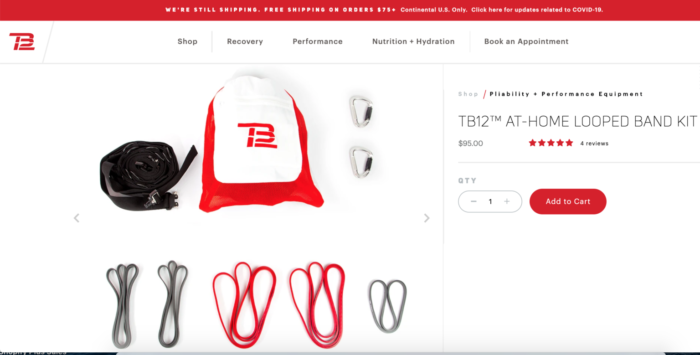
Product bundling best practices
The best thing about product bundling is it’s not set in stone, and you can always make modifications to bundles in the future. There’s a lot of room to test product bundles to see how well they go over, unlike changing up product packaging or making other changes at the manufacturing level, such as kits or sets that come assembled together as one cohesive unit and can’t be sold separately.
If you’re first starting out and you don’t have the historical sales data that proves which products are commonly sold together, don’t be afraid to try a different grouping of items and see if it drives more sales.
Bundles are meant to simplify pricing and the checkout experience, reduce the number of items a shopper adds to their cart, and provide suggestions and deals at the same time. Here are a few more tips for offering bundles:
- Discount the bundle so customers see the value.
- Show a bundle side-by-side with individual products, so a shopper sees how much it costs to buy the product by itself.
- Understand where bundles sit within the customer journey.
- Highlight bundles in emails during the holidays.
- Look at tangential industries — how do they price things, what’s included, and what are the main options?
- Test other websites to see how they try and upsell you.
Logistical challenges of product bundling
A product bundle is often predetermined, which means multiple items are sold together as a single unit. This can be an issue without proper inventory management and technology. If one unit is out of stock, then the bundle can no longer be sold. In order to properly offer product bundles, you have to make sure you have the right amount of stock for each unit included in the bundle to avoid backorders.
A third-party logistics (3PL) partner can help solve these challenges by offering the warehousing and technology you need to create and manage bundles, monitor and change individual components, and track inventory in real-time.
Kitting versus product bundling
If you decide to partner with a 3PL, it’s important to note the difference between kitting and product bundling. Kitting is done when your orders require fulfillment center associates to arrange items in a specific order (e.g., multiple component pieces that are separate at inventory arrival and need to be assembled or put together).A bundle contains several different items (i.e., not one item with multiple pieces) that are being shipped together. A bundle has no special assembly or preparation needed to ship the order. Creating a bundle will group multiple items under one main SKU. A bundle SKU is not a real product on its own but rather a ‘container’ that includes at least two or more items.
Single items or product bundles: ShipBob can help
ShipBob’s fulfillment solution makes it easy to create and modify product bundles through ShipBob’s dashboard. You’re also given full visibility into which items are being picked from their separate storage units to ensure orders are being shipped out correctly. You can still track inventory levels and sell these products separately or as part of a bundle.
Online jewelry brand Ocean and Co. likes to bundle items together as a packaged deal. By outsourcing fulfillment to ShipBob and integrating ShipBob with their Shopify store, they can see exactly what is picked off the shelf based on which products were in the assigned bundle. If a shopper makes a bundle purchase on their store, ShipBob automatically picks, packs, and ships the order.
They don’t use third-party Shopify apps to manage bundles and inventory counts, just ShipBob’s all-in-one software and fulfillment service. They’ve tried apps in the past for order bumps or upsells, but they found the best, most clean solution is to use ShipBob.
Best of all, Ocean & Co. remains in full control and doesn’t have to depend on someone else to manage the logistics side of bundles for them, even while a 3PL performs fulfillment services on their behalf. With a different fulfillment company they worked with, they had to rely on a game of telephone and someone else to create and update bundles for them, and the tracking of units was off.
“With ShipBob, we were able to mark any combination of SKUs as a unique bundle and select the component SKUs right through the dashboard. Each time that bundle was fulfilled by ShipBob, we could see the individual components that were physically picked, and we would know that the order went out as expected.
ShipBob also allowed us to make changes to bundles on the fly with complete control and visibility, which is important in monthly subscription boxes, holiday bundles, and many more scenarios.”
Gerard Ecker, Founder & CEO of Ocean & Co.
Not only does ShipBob make it easy to create bundles, ShipBob’s platform comes with built-in order and inventory management software, which gives you real-time inventory counts, the ability to set reorder point notifications at the SKU level, and much more. With our free analytics and reporting tool, you also get insights on SKU velocity, stock levels, and more.
Conclusion
Whether you’re selling on Amazon or your Shopify store, product bundling is a great marketing and sales tactic that can be used for the holiday season for shoppers looking for a predetermined grouping of gifts, or all year around to offer more value for your customers while driving more revenue. ShipBob makes product bundling easy.
If you’re looking for a trustworthy, tech-enabled 3PL, learn more about what ShipBob has to offer. Click the button below to request pricing.
